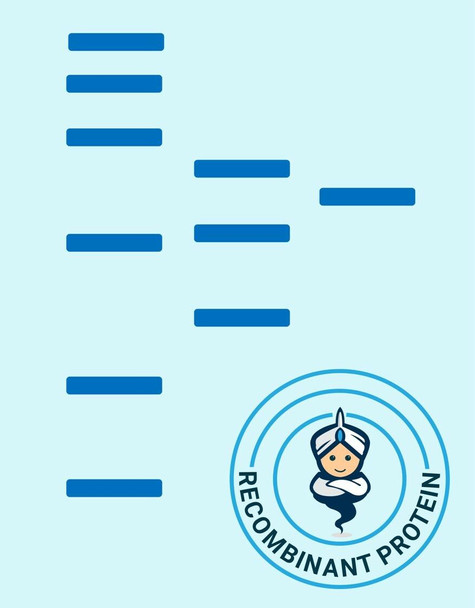Human ACP5 Recombinant Protein (RPPB5779)
- SKU:
- RPPB5779
- Product type:
- Recombinant Protein
- Size:
- 10ug
- Species:
- Human
- Target:
- ACP5
- Synonyms:
- Acid Phosphatase 5
- Tartrate Resistant
- Tartrate-Resistant Acid ATPase
- Human Purple Acid Phosphatase
- Source:
- Sf9 Insect cells
- Uniprot:
- P13686
Description
| Product Name: | Human ACP5 Recombinant Protein |
| Product Code: | RPPB5779 |
| Size: | 10µg |
| Species: | Human |
| Target: | ACP5 |
| Synonyms: | Acid Phosphatase 5, Tartrate Resistant, Tartrate-Resistant Acid ATPase, Human Purple Acid Phosphatase, EC 3.1.3.2, TrATPase, Tartrate-Resistant Acid Phosphatase Type 5, Tartrate-Resistant Acid Phosphatase 5a, Tartrate-Resistant Acid Phosphatase 5b, Tartrate-Resistant Acid Phosphatase, Type 5 Acid Phosphatase, TRACP5a, TRACP5b, TR-AP, HPAP, TRAP, ACP5. |
| Source: | Sf9 Insect cells |
| Physical Appearance: | Sterile Filtered colorless solution. |
| Formulation: | ACP5 protein solution (0.5mg/ml) contains Phosphate Buffered Saline (pH 7.4) and 10% glycerol. |
| Stability: | Store at 4°C if entire vial will be used within 2-4 weeks. Store, frozen at -20°C for longer periods of time. For long term storage it is recommended to add a carrier protein (0.1% HSA or BSA). Avoid multiple freeze-thaw cycles. |
| Purity: | Greater than 90.0% as determined by SDS-PAGE. |
| Amino Acid Sequence: | ATPALRFVAV GDWGGVPNAP FHTAREMANA KEIARTVQIL GADFILSLGD NFYFTGVQDI NDKRFQETFE DVFSDRSLRK VPWYVLAGNH DHLGNVSAQI AYSKISKRWN FPSPFYRLHF KIPQTNVSVA IFMLDTVTLC GNSDDFLSQQ PERPRDVKLA RTQLSWLKKQ LAAAREDYVL VAGHYPVWSI AEHGPTHCLV KQLRPLLATY GVTAYLCGHD HNLQYLQDEN GVGYVLSGAG NFMDPSKRHQ RKVPNGYLRF HYGTEDSLGG FAYVEISSKE MTVTYIEASG KSLFKTRLPR RARP |
| Biological Activity: | Specific activity is >10,000 units/mg, and is defined as the amount of enzyme that hydrolyze 1.0 nmoles of p-nitrophenyl phosphate (pNPP) per minute at pH 5.0 at 37°C. |
Tartrate-resistant acid phosphatase type 5 (ACP5) is involved in osteopontin and bone sialoprotein dephosphorylation. ACP5 is an iron containing glycoprotein which catalyzes the conversion of orthophosphoric monoester to alcohol and orthophosphate. ACP5 expression seems to increase in some pathological states such as Gaucher and Hodgkin diseases, the hairy cell, the B-cell, and the T-cell leukemias. ACP5 is the most basic of the acid phosphatases and is the only form not inhibited by L(+)-tartrate.
ACP5 Human Recombinant produced in Sf9 Baculovirus cells is a single, glycosylated polypeptide chain containing 304 amino acids (22-325 a.a.) and having a molecular mass of 34.3kDa (Migrates at 28-40kDa on SDS-PAGE under reducing conditions).ACP5 is purified by proprietary chromatographic techniques.
| UniProt Protein Function: | ACP5: Involved in osteopontin/bone sialoprotein dephosphorylation. Its expression seems to increase in certain pathological states such as Gaucher and Hodgkin diseases, the hairy cell, the B-cell, and the T-cell leukemias. Defects in ACP5 are the cause of spondyloenchondrodysplasia with immune dysregulation (SPENCDI). A disease characterized by vertebral and metaphyseal dysplasia, spasticity with cerebral calcifications, and strong predisposition to autoimmune diseases. The skeletal dysplasia is characterized by radiolucent and irregular spondylar and metaphyseal lesions that represent islands of chondroid tissue within bone. ACP5 inactivating mutations result in a functional excess of phosphorylated osteopontin causing deregulation of osteopontin signaling and consequential autoimmune disease. Belongs to the metallophosphoesterase superfamily. Purple acid phosphatase family. |
| UniProt Protein Details: | Protein type:Motility/polarity/chemotaxis; Phosphatase; Cofactor and Vitamin Metabolism - riboflavin; EC 3.1.3.2 Chromosomal Location of Human Ortholog: 19p13.2 Cellular Component: lysosome; integral to membrane; cytosol Molecular Function:acid phosphatase activity; ferric iron binding; ferrous iron binding Biological Process: riboflavin metabolic process; negative regulation of interleukin-12 production; defense response to Gram-positive bacterium; vitamin metabolic process; dephosphorylation; response to cytokine stimulus; negative regulation of nitric oxide biosynthetic process; negative regulation of inflammatory response; response to lipopolysaccharide; negative regulation of interleukin-1 beta production; negative regulation of tumor necrosis factor production; negative regulation of superoxide release; water-soluble vitamin metabolic process; bone resorption Disease: Spondyloenchondrodysplasia With Immune Dysregulation |
| NCBI Summary: | This gene encodes an iron containing glycoprotein which catalyzes the conversion of orthophosphoric monoester to alcohol and orthophosphate. It is the most basic of the acid phosphatases and is the only form not inhibited by L(+)-tartrate. [provided by RefSeq, Aug 2008] |
| UniProt Code: | P13686 |
| NCBI GenInfo Identifier: | 56757583 |
| NCBI Gene ID: | 54 |
| NCBI Accession: | P13686.3 |
| UniProt Secondary Accession: | P13686,Q2TAB1, Q6IAS6, Q9UCJ5, Q9UCJ6, Q9UCJ7, A8K3V2 |
| UniProt Related Accession: | P13686 |
| Molecular Weight: | 325 |
| NCBI Full Name: | Tartrate-resistant acid phosphatase type 5 |
| NCBI Synonym Full Names: | acid phosphatase 5, tartrate resistant |
| NCBI Official Symbol: | ACP5 |
| NCBI Official Synonym Symbols: | TRAP; SPENCDI |
| NCBI Protein Information: | tartrate-resistant acid phosphatase type 5; TrATPase; tartrate-resistant acid ATPase |
| UniProt Protein Name: | Tartrate-resistant acid phosphatase type 5 |
| UniProt Synonym Protein Names: | Tartrate-resistant acid ATPase; TrATPase; Type 5 acid phosphatase |
| Protein Family: | Acyl carrier protein |
| UniProt Gene Name: | ACP5 |
| UniProt Entry Name: | PPA5_HUMAN |










